The Application of the Undetermined Fundamental Frequency Method on the Period-Doubling Bifurcation of the 3D Nonlinear System
Abstract
The analytical method to predict the period-doubling bifurcation of the three-dimensional (3D) system is improved by using the undetermined fundamental frequency method. We compute the stable response of the system subject to the quadratic and cubic nonlinearity by introducing the undetermined fundamental frequency. For the occurrence of the first and second period-doubling bifurcation, the new bifurcation criterion is accomplished. It depends on the stability of the limit cycle on the central manifold. The explicit applications show that the new results coincide with the results of the numerical simulation as compared with the initial methods.
1. Introduction
Period-doubling bifurcation can induce complex dynamical behavior in the nonlinear dynamic systems. It is the most classical achievement broadcasted by Feigenbaum [1]. He discovered the ratio of the difference between the values at which such successive period-doubling bifurcation occurs at a constant of around 4.6692 and then showed that the same behavior, with the same mathematical constant, would occur within a wide class of mathematical functions, prior to the onset of chaos. Since then many attempts have been made to study the period-doubling (flip) bifurcation phenomenon in the nonlinear dynamic systems. Wang and Xu [2] developed the relation between two periodic solutions analytically for a general parameter dependent dynamic system. Such relation is further confirmed by one example and shows that the 2T-periodic solution contains all the information of the T-periodic solution near the bifurcation point. From the frequency domain point of view, Floquet multipliers commonly used for the analytical bifurcations of Hopf cycles are the key to detect the appearance of a subharmonic solution. So a quasianalytical monodromy matrix approach was developed to the period-doubling bifurcation emerging near a Hopf bifurcation point [3].
As compared with the single freedom system, the dynamical behaviors surrounding the bifurcation point may become more complicated in the 3D system. Rand [4] used the center manifold theory to approximate the newly born limit cycle and then to investigate the stability of the limit cycle corresponding to the flip bifurcation. Later, Belhaq et al. [5, 6] improved the approximation of the critical value with a higher-order approximation and further solved the problem of the second period-doubling bifurcation.
In this paper, we use the center manifold theory to reduce a 3D system and then derive the critical values of the first and second period-doubling bifurcation according to the stability of the limit cycle. In terms of the undetermined fundamental frequency method, it produces more accurate results and avoids the computational complexity appending the higher-order approximation at the same time [7, 8]. Finally the whole process is precisely programmed in terms of the computer algebra Mathematica to perform the analysis more efficiently.
2. Stable Response with the Undetermined Fundamental Frequency Method
This system may be thought of as a feedback control system consisting of a damped linear oscillator in the x, y variables and a control variable z. The origin (x, y, z) = (0,0, 0) is the equilibrium and may lose its stability at control parameter changing from μ < 0 to μ > 0. This means that the period-doubling bifurcation appears at the value μ = μc following the limit cycles.
The computational precision of the critical value depends heavily on the stable response, such as the frequency and amplitude of the 3D system. So, in order to perform the limit cycle bifurcation analysis more correctly, Belhaq et al. [6] explored the analysis through a higher-order approximation. In this paper we introduce the undetermined fundamental frequency method during the course of normal form operation.
3. Criterion for the Period-Doubling Bifurcation
In order to illustrate the accuracy of the result, the critical values obtained from different methods are presented in Table 1.
| Method | Numerical simulation | This paper | Reference [6] |
|---|---|---|---|
| μc | 0.476 | 0.481 | 0.486 |
In Figure 1, the projections on (z, x), (x, y), and (y, z) plane are plotted at the value of μc = 0.439. Meanwhile the time series of trajectories x(t), y(t), and z(t) appear in Figure 2. A 3D phase portrait refers to the first and second period-doubling bifurcations that are portrayed at the values μc equal to 0.439 and 0.476 in Figure 3, respectively. Finally we programme the whole computation process in terms of the computer algebra Mathematica to accelerate the analysis more efficiently.
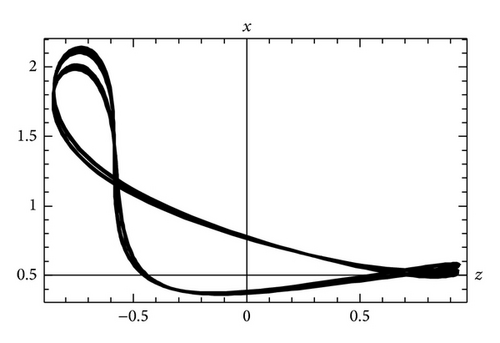
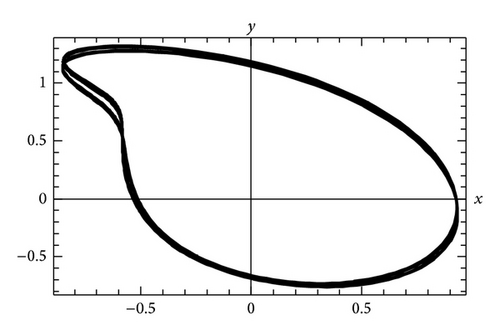

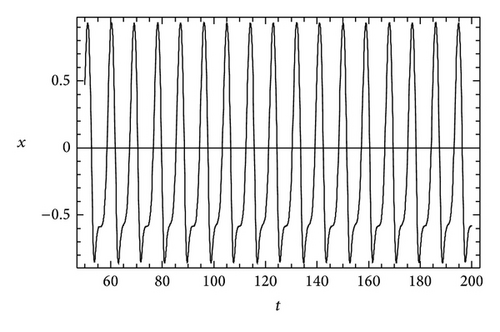
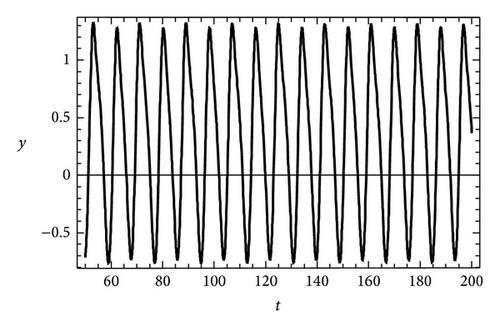
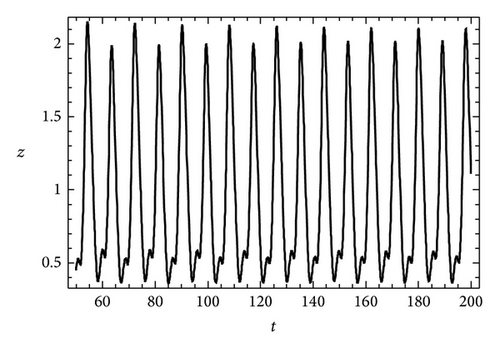
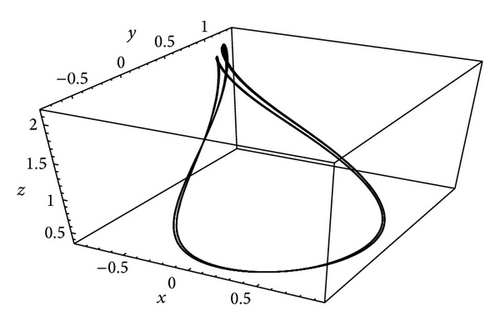
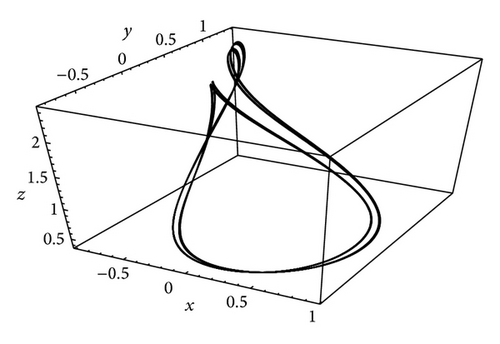
4. Conclusion
The strategy of predicting the period-doubling bifurcation of the 3D system is presented by using the undetermined fundamental frequency method. It applies the undetermined fundamental frequency to obtain the stable response of the flows on the center manifold and then forms the criterion of period-doubling prediction by considering the stability of the limit cycle. In contrast to the result of numerical simulation, it reveals a good prediction as shown in Tables 1 and 2, compared with the analytical results of the first and second period-doubling bifurcations given by Rand and Belhaq. The whole process is constituted in terms of the computer algebra Mathematica. It enables people to research the flip bifurcation of the 3D system more accurately and efficiently.
The strategy presented in this work is sufficiently general, so it would be possible to apply the present method to consider other high-dimensional and more complicated systems, which will be the topics for further research.
Acknowledgments
This work was supported by the National Natural Science Foundation of China (Grant no. 11272229) and Science Foundation of Tianjin Education Committee (Grant no. 20120902).




